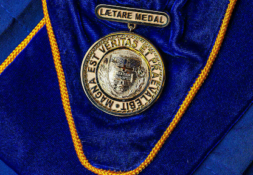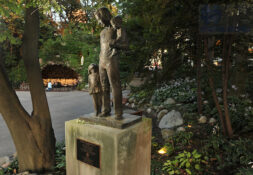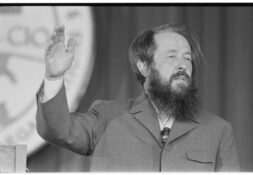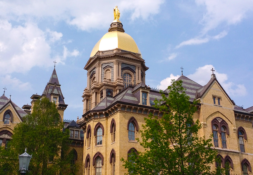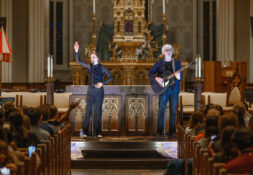Students explore the history of English conversion and martyrdom
The de Nicola Center for Ethics and Culture (dCEC) organized a week-long pilgrimage over spring break for selected applicants of its Sorin Fellows cohort. Thirty students visited historical and holy sites across England, including Ramsgate, Canterbury, London, Stonor Park, Oxford, and Salisbury. They also attended seminars on Ss. Thomas More, Edmund Campion, Robert Southwell, and John Henry Newman, as well as authors G.K. Chesterton and C.S. Lewis.
David Younger, the dCEC Student Formation Program Manager, told the Rover, “With the richness of the Catholic intellectual and moral traditions, a pilgrimage to the UK with a focus on martyrs and converts fits with our programming rather well.”
He continued, “A pilgrimage can be often described as a journey, sometimes internationally, where one is in search of personal growth and, in the Catholic context, through a spiritual lens where one’s faith is explored and reflected upon for the purpose of deepening our relationship with God.”
Stories of martyrdom and conversion from the history of English Catholicism lay at the heart of excursions on the pilgrimage, and the pilgrimage began with a trip to a central site in the conversion of England. This first stop took pilgrims to the Shrine of St. Augustine of Canterbury in Ramsgate, which stands near the spot where St. Augustine landed after he was sent to the island by Pope Gregory the Great in the sixth century to evangelize England.
The current shrine, built in the 19th century by Augustus Pugin—the famed architect of Parliament’s clock tower ‘Big Ben’ and a convert to Catholicism—replaced an original shrine to the apostle to England that stood further inland at Canterbury but was destroyed during the Protestant Reformation.
Father Bill Dailey, C.S.C. accompanied the students as chaplain and celebrated daily Mass throughout the pilgrimage at various shrines, oratories, and priories. When discussing the pilgrimage with the Rover, Fr. Dailey noted “how blessed we were to be able to walk and pray where great saints walked and prayed.”
“There’s something in the traveling, the walking, and in being in the very place that moves the heart and shapes the imagination,” he concluded.
The pilgrimage continued to the site of St. Thomas Becket’s martyrdom at Canterbury Cathedral and the site of St. Thomas More’s imprisonment, death, and likely burial at the Tower of London.
Canterbury Cathedral originally housed the relics of St. Thomas Becket and was one of the most visited pilgrimage sites in Christendom, as seen in Geoffrey Chaucer’s Canterbury Tales. Fellows were unable to venerate the relics of Becket in Canterbury though, as they were either covertly transferred or destroyed during the English Reformation. The group revered a smaller relic of St. Augustine of Canterbury—whose relics suffered a similar fate as Becket’s during the Reformation—at the shrine in Ramsgate because a small portion of his bone was sent abroad to Europe in the decades preceding the Reformation.
While at the Tower of London, a few fellows were able to join Fr. Dailey in prayer in the cell where St. Thomas More was imprisoned. More, a faithful Catholic who served as Lord Chancellor of England, is remembered for his refusal to recognize King Henry VIII as the supreme head of the church in England. Other pilgrims visited Beauchamp Tower, where Catholics imprisoned during the Reformation left carvings—many of them biblical quotations in Latin—in the walls, forever memorializing their witness to the faith in the face of persecution.
Throughout the week, the pilgrims also visited other sites connected to various English martyrs. One such site was Tyburn Abbey, a cloistered convent a few hundred yards from the site of the Tyburn Tree, where many Catholics—including St. Edmund Campion—were executed for their adherence to the faith. At Stonor Park, a country manor owned by a recusant Catholic noble family, the pilgrims saw the room where Campion hid from royal authorities and secretly published his Decem Rationes, the apologetic tract that led to his capture, torture, and execution.
The pilgrims also encountered stories of conversion throughout England. They spent an afternoon at the Notre Dame London Global Gateway, where they engaged in a seminar on G.K. Chesterton, the English journalist and convert, and viewed pieces from the Chesterton Archive. Additionally, as they made their way to Oxford, the pilgrims visited Littlemore, where St. John Henry Newman retreated from the university to pray and write. It was in this small cottage in 1845 that Newman was received into the Church by Blessed Dominic Barberi.
Sophomore Sorin Fellow Theo Austin told the Rover, “We had the opportunity to learn about and discuss the thoughts of many English greats, most notably St. John Henry Newman. As a focus of the trip, the concept of a ‘second spring’ of the Catholic Church in England brought me to a deeper understanding of the life of the Church there and an understanding of the new life which has and will be emerging through the witness of the saints and martyrs.”
During their time at Oxford, the pilgrims were able to walk in the footsteps of Newman, C.S. Lewis, and J.R.R. Tolkien. They attended Mass at Tolkien’s home parish, the Catholic Church of Ss. Gregory and Augustine, and the University of Oxford’s Blackfriars Hall Dominican chapel, before engaging in seminars on Newman’s and Lewis’ conversions.
On the last day of the pilgrimage, separate groups of Sorin Fellows took a country walk through the Cotswolds in the footsteps of Lewis and Tolkien, traveled to Salisbury to visit the cathedral, or stayed in Oxford.
Junior Sorin Fellow Katiebelle Thompson remarked on the effects of the pilgrimage: “Before this trip, I did not know how rich its history of Catholic martyrdom was, and I certainly gained a deeper appreciation for English Catholicism’s spirit of survival, loving dedication, and perseverance. … It was very humbling to see the immense self-sacrifice of the English saints. It was inspiring and has awakened my curiosity about a life of voluntary asceticism.”
Prior to the trip overseas, the dCEC hosted events that exemplified the faith of Becket and More. Students participated in and watched a staged reading of T.S. Eliot’s Murder in the Cathedral, which recounted Becket’s death at the hands of agents of Henry II. Earlier in the semester, the future pilgrims attended a big-screen showing of the acclaimed film, A Man for All Seasons, which depicts More’s final years as Lord Chancellor.
Jason Baxter, visiting associate researcher at the dCEC, also accompanied the students on the trip and directed the academic seminars during the pilgrimage. He told the Rover, “England is a place that a lot of us have visited or will visit, but we don’t often go there with an eye to its spiritual heritage. This trip, in a way, was a surprising trip, because we were trying to rediscover, to get a feel for a whole forgotten chapter of the Church’s life.”
Madelyn Stout is an Anglophile studying English and political science. She embraced the spirit of Tolkien on the pilgrimage, having known half of the participants half as well as she should like, and liking less than half of them half as well as they deserve. If you want to hear about her time in St. Thomas More’s cell, watch Masterpiece Theater, see her picture with a Dalek, translate Old English, or enjoy a spot of tea, email her at mstout2@nd.edu.
Subscribe to the Irish Rover here.
Donate to the Irish Rover here.
Photo Credit: The de Nicola Center for Ethics and Culture
